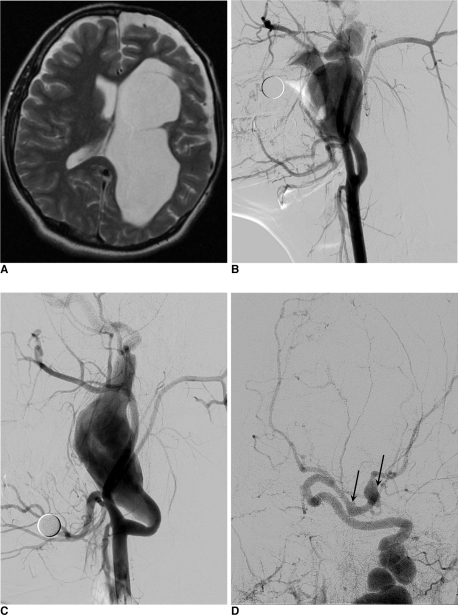Neurointervention.
2011 Feb;6(1):34-37. 10.5469/neuroint.2011.6.1.34.
Intracranial and Extracranial Fusiform Aneurysms in a Patient with Neurofibromatosis Type 1: A Case Report
- Affiliations
-
- 1Department of Radiology, Kyung Hee University Hospital, Seoul, Korea. euijkim@hanmail.net
- KMID: 1783981
- DOI: http://doi.org/10.5469/neuroint.2011.6.1.34
Abstract
- Neurofibromatosis type 1 (NF-1) has a variety of localized or systemic manifestations. Among them, Cerebrovascular dysplasia can be very rare finding of neurofibromatosis which can be very rarely seen. Here we report a case of 17-year-old boy representing bilateral giant fusiform aneurysms of extracranial internal carotid arteries and intracranial aneurysms of left middle cerebral artery. He showed no related symptoms at all, but screening for vascular lesions and close monitoring is warranted in NF-1 patients considering that it can be symptomatic unexpectedly.
MeSH Terms
Figure
Reference
-
1. Fortman BJ, Kuszyk BS, Urban BA, Fishman EK. Neurofibromatosis type 1: a diagnostic mimicker at CT. Radiographics. 2001; 21:601–612. PMID: 11353109.
Article2. Rosser TL, Vezina G, Packer RJ. Cerebrovascular abnormalities in a population of children with neurofibromatosis type 1. Neurology. 2005; 64:553–555. PMID: 15699396.
Article3. Bognanno JR, Edwards MK, Lee TA, Dunn DW, Roos KL, Klatte EC. Cranial MR imaging in neurofibromatosis. AJR Am J Roentgenol. 1988; 151:381–388. PMID: 3134807.
Article4. Schievink WI, Riedinger M, Maya MM. Frequency of incidental intracranial aneurysms in neurofibromatosis type 1. Am J Med Genet A. 2005; 134A:45–48. PMID: 15690406.
Article5. Ku YK, Chen HW, Fu CJ, Chin SC, Liu YC. Giant extracranial aneurysms of both internal carotid arteries with aberrant jugular veins in a patient with neurofibromatosis type 1. AJNR Am J Neuroradiol. 2008; 29:1750–1752. PMID: 18556363.
Article
- Full Text Links
- Actions
-
Cited
- CITED
-
- Close
- Share
- Similar articles
-
- Stent-Assisted Coil Trapping in a Manual Internal Carotid Artery Compression Test for the Treatment of a Fusiform Dissecting Aneurysm
- Intracranial Fusiform Aneurysms: It's Pathogenesis, Clinical Characteristics and Managements
- Clinical Results of in situ Vascular Reconstruction for the Treatment of Complex Intracranial Aneurysms
- Concurrent Intracranial and Extracranial Arterial Aneurysms: Report of Three Cases
- Multiple Cerebral Aneurysms Associated with Extracranial Carotid Aneurysm: Case Report


